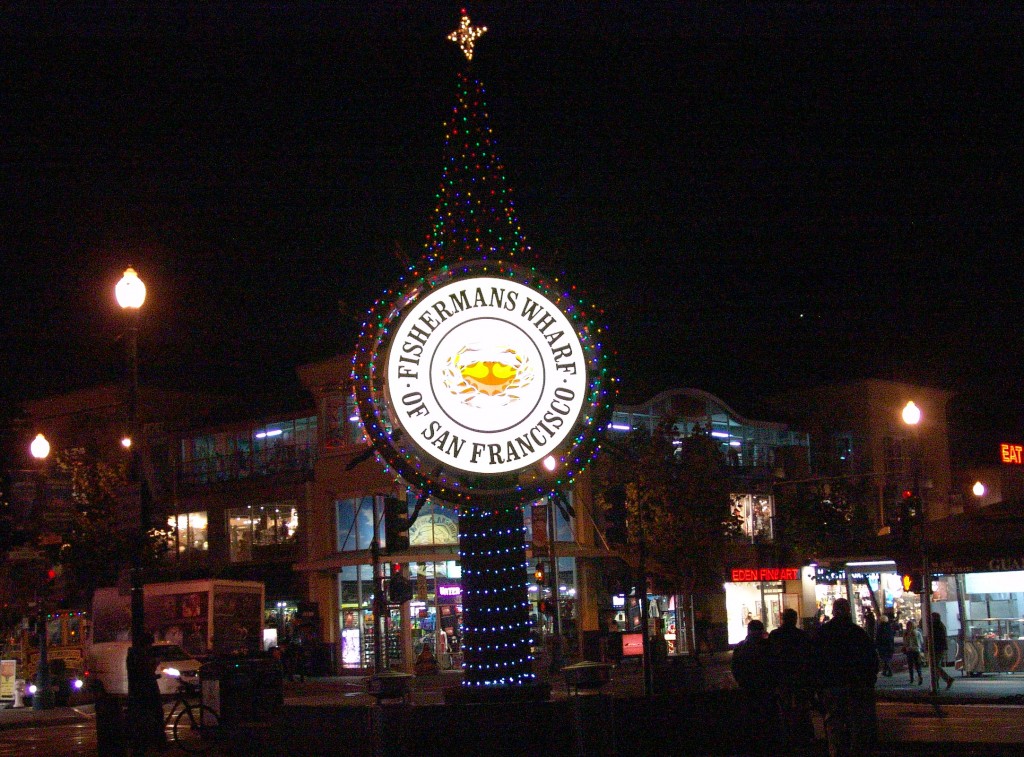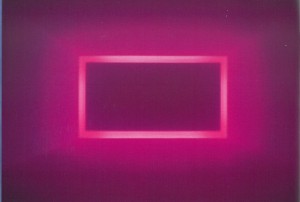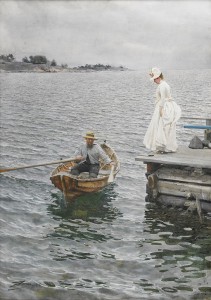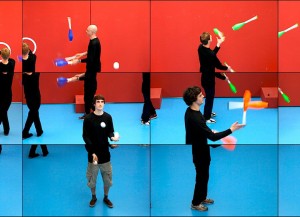
The internet said eighty degree weather in California the first week of December. So, husband Dave and I left our mittens in the car before flying to Los Angeles for a bankruptcy conference and Fall art, Western style. At Terranea Resort, Dave listened to the latest on staying financially afloat while I hunkered down to read my PhD homework, watching palm trees sway and patio doors rattle and bang. I kept hearing Sinatra singing, “hate California, it’s cold and it’s damp.”
Catalina Island looked like a cake submerged in whipped cream.
Thinking I needed a time-out from Schopenhauer and Nietzsche, I paid a hundred dollars for a resort painting class. The two-hour session was given by a former women’s professional basketball star—a charming lady who was clueless about art. Apparently, Terranea thought picnic tables could substitute for easels. The spectacular view, a rocky bluff typical of California coastline, was the only motif to paint and overwhelmed the novice guests. We were given three tubes (red, yellow, and blue) of cheapy Galleria paint, brushes I wouldn’t use to baste a turkey, and canvas-board the size of a legal pad. If we were good, we got a bit of black and white. I was beginning to think I had been given a part in Shawshank Redemption.
In my Alaska studio, I’ve spent many hours cleaning up after granddaughter Averyl, letting her use my Golden paints, hog hair brushes and rolled canvas remnants. Even though I joke the sink drain was the beneficiary of my efforts, we had loads of fun splashing around, talking about color while using good materials.
Back on the Terranea picnic tables our basketball star showed us how to begin painting the bluff. She produced a canvas-board demo; someone had washed on pthalo blue into a shape resembling a sideways ‘U’ which was supposed to look like the proverbial landscape. The only instructions from our basketball pro were, “The resort doesn’t want to show a done painting as that would intimidate and you should observe the different blue in the ocean.” I never leave home without watercolors and actually had a lovely two hours painting the dead grasses in the parking lot. However, one hundred bucks is too much to pay for kiddie paint supplies and a faux-instructor.
With Dave happily absorbing bankruptcy chapters, I headed to the Los Angeles County Museum of Art on famed Wilshire Boulevard. LACMA was established in 1910 and is the largest art museum in the West. Unlike New York’s Metropolitan there is a lot of open space surrounding galleries. Concert areas and a restaurant/bar nestle amongst palm trees near the recent addition by Renzo Piano which has a red outdoor stair system resembling his Paris Pompidou design. Michael Heizer’s 340 ton boulder, Levitated Mass, now with its tarpaulin removed, resides atop a pedestrian underpass. Museum attendees walk underneath and experience the sublime, confident this rock is unlikely to become unhinged.
James Turrell, A Retrospective, on view until April 6, 2014, is about painting with light instead of creating imagery with pigments or clay. A video by Art:21 explains Turrell’s perspective on the importance of light and how it’s overlooked—can’t see form without illumination. Viewers walking through this exhibition experience garish lighting, formed into geometric patterns. Turrell plays mind games as some shapes are imaginary while others are really holes in a wall. Holograms of rectangles and ovals push and pull as visitors try to outwit the hallucinations. A Barbie-pink room is totally illusory.

Musuem goers can don slippers and climb steps reminiscent of a neoclassical temple, before entering a light chamber. There a morphing spectrum surrounds people balancing on a slanted floor surrounded by curved walls, nothing seems solid or secure. Turrell wants to make the point that light is physically present and insists, “I make spaces that apprehend light for our perception, and in some ways gather it, or seem to hold it …my work is more about your seeing than it is about my seeing , although it is a product of my seeing.”
Turrell, a psychologist turned artist, is known for his Skyspaces, small enclosures with a hole in the ceiling. Visitors sit on sauna-style benches and contemplate a keyhole of sky devoid of our material world. The closest Skyspace to Alaska can be found on the University of Washington campus.
Since 1974, Turrell has been constructing a light observatory carved out of Arizona’s Roden crater. Not open to the public yet, he says, “it’s not about the landforms …I’m working to bring celestial objects like the sun and moon into the spaces that we inhabit.”
Dave and I left LA-LA land and the Christmas tree vendors who’ll spray fake snow on your flora, hugged our LA son Oliver, and flew to San Francisco for more Fall art. In spite of the recent financial down-turns, the California Palace of the Legion of Honor and the M. H. de Young Memorial Museum have continued to curate spectacular shows.
Anders Zorn, Sweden’s Master Painter, on view at the Legion until February 2nd 2014, is considered the John Singer Sargent of Sweden because of his technical modelling abilities combined with his painterly textures. Like Sargent, his use of lead white in appropriate places attracts a viewing eye which reacts to his compositional zing. Zorn also painted in watercolor and became a celebrity portraitist of the Guilded Age, painting Theodore Roosevelt and Mrs. Potter Palmer of Chicago’s Gold Coast. Wind pushing water, whether as rain splashing pedestrians in an urban street scene, or as waves lapping against a bobbing rowboat, his use of liquidity is realistic and sensual. Zorn nudes resemble goddesses while men in frock coats look industrial. Female laborers in a brewery could be pitied, but the light bouncing off the bottles they are corking dazzles onlookers who forget the tedium described.

Tourists have time to experience Zorn at the Legion and get over to the de Young for lunch. Dining at the Legion overlooking the Bay is nicer in warmer weather. In a large plastic tent outside the deYoung Café, the only time we felt sun and warmth, Dave and I sipped spinach-potato puree along with a plate of tomato drenched meatballs garnished with pecorino cheese.
Once refreshed, we tackled David Hockney, A Bigger Exhibition, on view until January 20th 2014. Hockney is an artist-survivor who gained fame during the sixties’ Pop Art era with his splashy eye-candy paintings of post-war California– palm trees poolside and desert backdrops.
Hockney still paints huge sherbet lime, orange and raspberry masterpieces depicting both California’s chaparral and England’s ‘green a pleasant land.’ A closer look reveals that these huge works are really smaller paintings joined together like floor tessellations. A keen viewer will notice each segment could stand as an original composition.

Hockney also uses a bold palette for portraiture, reminiscent of the late Alice Neel. He situates figures ‘up-front and personal’ as his models stare out into the gallery against Kelly green backgrounds. Hockney manipulates horizon lines, the intersection where the floor and walls meet, which alters the haughty demeanor of his figures juxtaposed by their casual sweaters and jeans.
Missing in this exhibition are Hockney’s collages made from point and shoot snapshots. By overlapping the almost identical photos, he produced the effect of a flat-work that seems to move, like early motion pictures. Displaying one of these collages would have made a nice transition into his computer-generated art. Hockney must have deduced that to continue as a superstar meant assimilating into the Postmodern/computer age.
He computer-sketches as drafts for one of his original artwork, and visa-versa he scans and prints charcoal drawings using electronic equipment. I’m sure younger artists, who grew up with ‘i-everything’ sneer at Hockney’s attempts to be computer savvy. Hell, he adapted when he was already ‘laughing all the way to the bank,’ largesse from his Pop Art years.
I watched as his equally colorful videos mesmerized gallery hoppers. Multiple video screens of almost identical subject matter play in sync. As with his giant canvasses, a viewer can shut one eye and observe each movie as a complete unit or see that the multiple screens move together in a kind of hyperactivity. In Hockney’s video of a dense forest, trees seem to fold into cracks at the film edges or vanish only to show up on an adjacent screen. Using the same technique, he orchestrates jugglers who roll hoops and toss bowling pins from one film segment to another or vanish like the stumps of trees that fall in between the gaps of the footage.
Fisherman’s Wharf may be hokey to Bay Area residents, but like New York’s Times Square it’s a great place to people watch–there’s plenty of validated parking too. The wharf’s signature steering wheel was decked out while blow-up Santas sat in the wheel housing of tied up fishing boats. We slurped bouillabaisse at Alioto’s overlooking the harbor. And on our last night we ate crab mac and cheese along with sourdough upside-down bread pudding (whipped cream, caramel and berries) at Boudin’s Bakery. The Boudin manager kept handing us sourdough baguettes which we managed to get through San Francisco’s airport security.
Turrell, Zorn and Hockney catalogs available through Amazon.
Happy Holidays to Alaska’s art-lovers.




